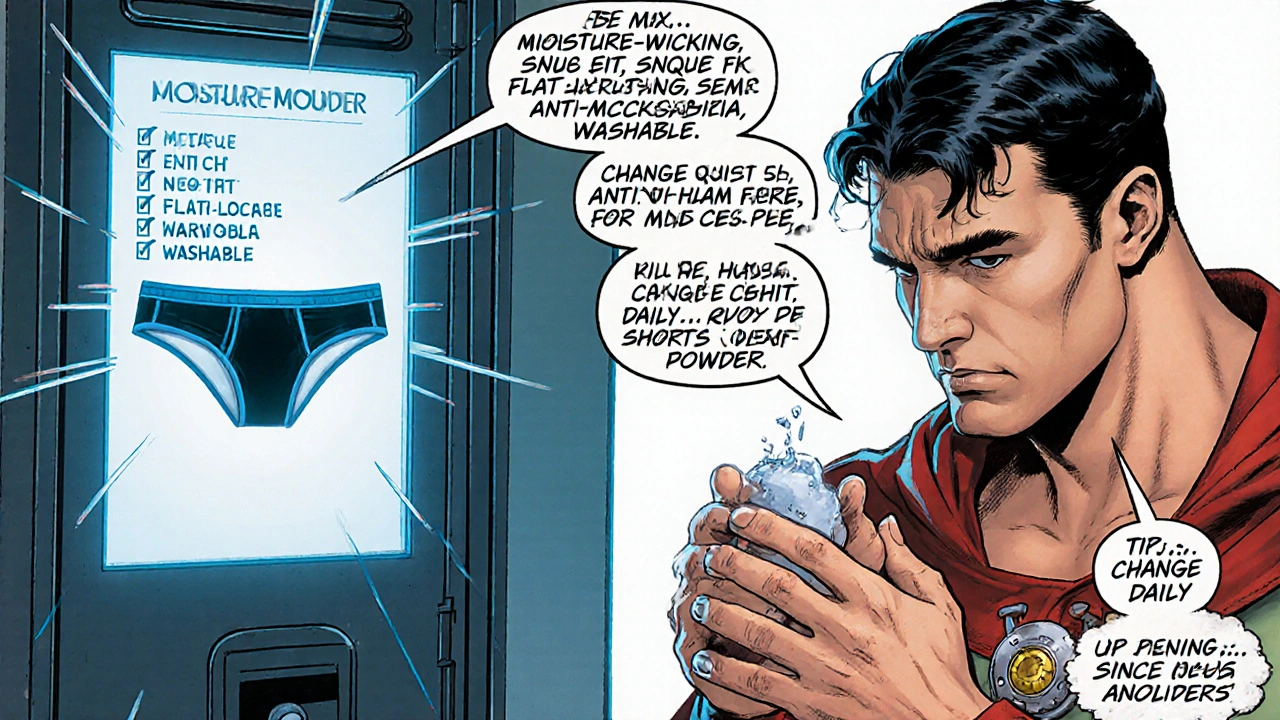When it comes to staying comfortable and keeping jock itch a fungal infection that loves warm, damp places at bay, the right underwear the piece of clothing that touches your skin for hours each day can make all the difference. You might think any pair will do, but the fabric, cut, and fit directly affect moisture, airflow, and friction - the three main triggers for that itchy rash.
Why your underwear matters for jock itch
Jock itch, medically known as tinea cruris, thrives when two conditions meet: excess sweat and a lack of ventilation. Your underwear acts like a second skin; if it traps heat, the fungus finds a perfect home. On the flip side, a breathable, well‑fitted pair pulls moisture away, dries quickly, and reduces friction, cutting the fungus’s runway.
Key attributes to look for
Not all underwear is created equal. Below are the five attributes that actually matter, not just marketing buzz.
- Moisture management: Fabrics that wick sweat away and dry fast keep the groin area dry.
- Fit and seam placement: A snug but not tight fit prevents chafing while avoiding excess compression.
- Material breathability: Natural fibers or engineered synthetics that let air flow.
- Antimicrobial treatment: Some fabrics are treated to inhibit fungal growth.
- Seamless or flat‑lock construction: Reduces irritation from rubbing seams.
Materials compared
Below is a quick side‑by‑side look at the most common fabrics. This table uses Moisture‑wicking fabric textiles engineered to pull sweat away from skin as the benchmark for performance.
| Fabric | Moisture‑Wicking | Breathability | Antimicrobial | Typical Use |
|---|---|---|---|---|
| Cotton (high‑quality) | Low - absorbs moisture | Good | None | Everyday wear |
| Moisture‑wicking synthetics (poly‑ester/nylon blends) | High - moves sweat to surface | Excellent | Often treated | Sports & active days |
| Antimicrobial treated blends | High | Very good | Yes - silver or copper ions | High‑risk activities |

Fit matters more than you think
Even the best fabric can fail if the cut is wrong. Here’s what to avoid and what to aim for:
- Too tight: Compresses skin, traps heat, and creates friction. Look for a snug but move‑with‑you feel.
- Too loose: Allows the fabric to bunch, creating pockets where sweat pools.
- Flat‑lock seams: Unlike traditional seams that dig in, flat‑lock seams lay flat, cutting down on chafing.
- Seamless designs: Ideal for marathon runners or anyone who spends hours on the move.
Real‑world picks for different needs
Below are three recommendations that cover most lifestyles. All are widely available in South Africa and abroad.
- Everyday comfort - 100% combed cotton boxer briefs: Look for a breathable weave with a mid‑rise elastic. Brands like Fruit of the Loom or local producers such as Javina offer affordable options.
- Active days - moisture‑wicking synthetic boxers: Products from Under Armour or Nike Dri‑Fit pull sweat away and dry within minutes, keeping the groin dry during training.
- High‑risk situations - antimicrobial treated performance briefs: Silver‑infused fabrics from Smartwool or Icebreaker actually inhibit fungal growth, adding an extra layer of protection for marathoners, cyclists, and players.
Hygiene habits that complement good underwear
Choosing the right pair is only half the battle. Pair it with these simple habits to keep jock itch at bay:
- Change underwear at least once a day - more often if you sweat heavily.
- Wash with an antibacterial soap and dry thoroughly before dressing.
- Avoid tight athletic shorts over your underwear; they can trap heat.
- Consider a talc‑free powder or an antifungal spray after showering.
- Keep gym clothes separate from daily wear in the laundry.

Common pitfalls and how to avoid them
Even seasoned athletes slip up. Spot these red flags before they cause trouble:
- Re‑using worn‑out briefs: Fabric loses its wicking ability after many washes.
- Choosing “fashion” over function: Silk or decorative fabrics look great but trap moisture.
- Neglecting laundry hygiene: Using fabric softener can coat fibers, reducing breathability.
- Ignoring personal comfort: If a pair feels itchy or tight, it will only get worse during activity.
Quick checklist before you buy
- Is the material moisture‑wicking or quick‑dry?
- Does the cut provide a snug but non‑compressive fit?
- Are seams flat‑lock or is the design seamless?
- Is there an antimicrobial coating?
- Can you wash it without losing performance?
Keep this list in mind next time you shop, and you’ll walk away with underwear that actually helps prevent underwear for jock itch.
Frequently Asked Questions
Can cotton underwear prevent jock itch?
Cotton is breathable but it absorbs sweat, which can stay damp longer than synthetic wicking fabrics. High‑quality, lightweight cotton works for low‑activity days, but for sports or heavy sweating, moisture‑wicking synthetics are a better choice.
Do antimicrobial treatments really stop fungus?
Silver, copper, or bamboo‑based antimicrobial finishes inhibit fungal growth by disrupting cell membranes. They don’t replace good hygiene, but they add a protective layer, especially useful for athletes who can’t change underwear frequently.
How often should I replace my underwear?
Most experts recommend a new pair every 6‑12 months for everyday wear and every 3‑4 months for performance underwear, because fabric elasticity and wicking effectiveness degrade over time.
Is seamless underwear worth the price?
For people who experience chafing, seamless designs remove friction points and can be a game‑changer. If you’re mostly sedentary, the added cost may not be necessary.
What other habits help prevent jock itch?
Regularly wash your groin area with a mild antifungal cleanser, keep the area dry, wear breathable socks, and avoid sharing towels or clothing. Pair these habits with the right underwear for the best defense.





Mary Wrobel
October 15, 2025 AT 20:04Thanks for pulling together such a clear guide, it's super helpful for anyone dealing with that pesky itch. I love how you broke down the fabric choices and actually explained why breathability matters. The checklist at the end is a perfect quick‑reference for a busy morning. Keep the practical tips coming!
Lauren Ulm
October 19, 2025 AT 16:04It's fascinating how the underwear we wear can be a silent accomplice in a fungal conspiracy 🌱🔬. If you think the fabric alone decides the outcome, you're ignoring the hidden network of moisture‑trapping micro‑environments that thrive in our daily routines 😊. Choosing the right threads is like picking allies in a covert war against invisible invaders.
Michael Mendelson
October 23, 2025 AT 12:04Honestly, most people just dont get it – they wear cheap cotton and expect miracle results. Its a moral failing, a disregard for personal hygiene that i cant even begin to condone. If you want to avoid jock itch you gotta invest in performance gear, not some flimsy fashion statement. Stop making excuses, upgrade your undies.
Ibrahim Lawan
October 27, 2025 AT 07:04When we examine the problem of jock itch from a physiological perspective, the role of thermoregulation becomes paramount. Sweat accumulation creates a micro‑habitat where dermatophytes can proliferate unchecked. The choice of material directly influences evaporative cooling efficiency, thereby reducing surface moisture. Natural fibres such as high‑quality cotton provide adequate breathability but lack rapid wicking capabilities. Synthetic blends engineered for moisture transport accelerate the evaporation process, maintaining a drier epidermal surface. Moreover, the seam construction determines frictional forces that can compromise the stratum corneum. Flat‑lock seams distribute pressure evenly, minimizing skin irritation that could otherwise act as an entry point for fungi. Antimicrobial treatments, often incorporating silver ions, introduce an additional biochemical barrier by disrupting fungal cell membranes. Yet such treatments should be viewed as complementary rather than primary safeguards. Consistent personal hygiene practices, including thorough drying after washing, reinforce the protective effects of suitable underwear. Rotating garments to allow complete drying between uses further mitigates moisture retention. Regular replacement of performance briefs, approximately every three to four months, preserves their engineered properties, as wear diminishes wicking efficiency. Finally, integrating these strategies into a holistic routine aligns clothing choices with broader health objectives, fostering resilience against opportunistic infections.
Just Sarah
October 31, 2025 AT 03:04Having considered the anatomical nuances, one must also acknowledge the sociocultural implications; indeed, the stigma associated with fungal infections often deters individuals from seeking optimal solutions. Consequently, the dissemination of accurate, evidence‑based guidance is not merely a matter of comfort, but a public‑health imperative.
Anthony Cannon
November 3, 2025 AT 23:04Great points!
Kristie Barnes
November 7, 2025 AT 19:04I totally get where you're coming from – the right fit really does make a world of difference. I’ve tried a few seamless options and they’re super comfy for long days at the desk. It’s nice to hear a balanced take on the whole thing.
Zen Avendaño
November 11, 2025 AT 15:04That’s a solid rundown. I’ve found that a snug but not tight boxer brief works best for the gym, and the flat‑lock seams keep the chafing at bay. Glad to see the guide covering both performance and everyday wear.
Michelle Guatato
November 15, 2025 AT 11:04Wake up, folks! The powers that be don’t want you to know that your underwear is an espionage tool against your own body 👽🕵️♀️. The elites push cotton “comfort” while they secretly coat it with micro‑agents that trap moisture. Switch to silver‑infused tech before they control the humidity of your groin!
Gabrielle Vézina
November 19, 2025 AT 07:04Honestly the hype around “moisture‑wicking” is overblown. It’s just marketing gibberish, and the real issue is personal neglect. Stop buying hype and start washing properly.
carl wadsworth
November 23, 2025 AT 03:04I hear you both. While the tech fabrics have their merits, we shouldn't overlook simple habits like changing daily and keeping things clean. Balance is key – use what works for you without getting caught up in the noise.
Neeraj Agarwal
November 26, 2025 AT 23:04Grammar matters even in casual advice. For instance, “its” versus “it’s” can change meaning. Also, avoid misspelling key terms like “antimicrobial” – precision helps everyone understand the science.
Leah Robinson
November 30, 2025 AT 19:04Love the positivity here! 😊 Remember, a good pair of briefs plus a little routine can keep you feeling fresh all day. Keep sharing these awesome tips!